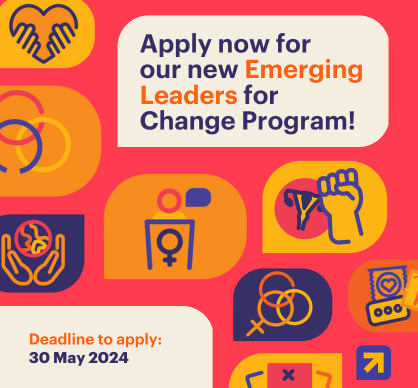Irrespective of the circumstances of her birth, the most powerful decision-maker in a baby’s life is not a doctor, a teacher, a government official or a religious figure, but her mother.
As powerful as these traditional authorities may be, it is a mother who decides whether or not to continue with a pregnancy, how to nourish herself and her child, when to respond if a child is sick and how to nurture child development in the early years.
When mothers have the right knowledge and tools to exercise their power, babies can thrive. However, when mothers are restricted in any way – by lack of education, limited financial clout, no agency in the household, discriminatory legal restrictions or lack of access to services – their own health and their baby’s health can be at grave risk.
Seen in this light, many of our major development challenges, from reducing deaths in pregnancy and childbirth to ending newborn mortality and child malnutrition, are actually outcomes of mothers lacking the instruments to exercise their own power.
With just a few tools – a high school education, a paid job, access to contraception, decision-making power in the household and outside help when needed – mothers could prevent most of the deaths that occur in pregnancy, childbirth and childhood.
How?
If all mothers were free to make the following ten decisions, most of the negative events that sustain the high rates of poverty, inequality, sickness and death in too many parts of the world could be prevented.
The 10 Decisions Every Mother Needs to be Free to Make
1. EARNING AN INCOME
If every mother earned and controlled her own money, almost every measure of human development would improve, including economic growth, poverty and inequality, health and education, and, in the long-run, even peace and security. Yet the proportion of women who are employed globally has remained stuck at around 50 percent since 2000, and there are an estimated 1.4 billion unemployed women in the world today, most of whom are mothers (World Bank).

2. USING CONTRACEPTION
If every woman could control if, when and how many children she had, she could simultaneously improve her own health, education and employment and invest more in her children. For example, if all women who wanted to use contraception could do so, deaths in pregnancy and childbirth and newborn deaths would fall by a massive 60 percent. Yet currently 225 million married or partnered women and an estimated 570 million single women have an unmet need for modern contraception (Guttmacher Institute). Further, 290,000 women still die in pregnancy and childbirth every year and 2.7 million babies die in the first month of life (UNFPA and UNICEF).

3. LEARNING TO READ AND WRITE
The more educated a mother the more likely her children are to survive and thrive. An astonishing half of the reduction in child deaths in recent decades is the result of increases in the education of women of reproductive age (Institute for Health Metrics and Evaluation), yet women still make up 64 percent of the world’s 780 million illiterate adults. Shockingly, in twelve countries more than 60 percent of adult women are illiterate, including Niger, Guinea, Burkina Faso, the Central African Republic, Benin, Afghanistan, Mali, Chad, Cote d’Ivoire, Liberia, Sierra Leone and Ethiopia (UNESCO).

4. EATING NUTRITIOUS FOOD
If every woman entered pregnancy with a well-nourished body, the risks of maternal and child death would fall. Yet women and children under five account for the majority of malnourished people in the world. Women are 52 percent of all underweight adults and 60 percent of all obese adults (Lancet). In India alone 42 percent of women enter pregnancy underweight (Research Institute for Compassionate Economics). Although child stunting is falling, there are still 156 million children who suffer this form of chronic malnutrition (UNICEF).

5. BREASTFEEDING EARLY AND OFTEN
If all mothers insisted on breastfeeding their babies within an hour of birth and continued for six months, up to 800,000 child deaths could be prevented each year (Lancet). Yet less than half of all newborns are breastfed within an hour of birth and for the first six months of life. Most mothers in the world still lack access to breastpumps at home and at work and to donor human milk when they cannot breastfeed.

6. PRACTICING SKIN-TO-SKIN CARE
Preterm birth is now the leading cause of death among children under five. Fifteen million babies are born too soon each year and one million die (WHO). If mothers were able to keep their newborns close by, practicing so-called “Kangaroo Mother Care”, hundreds of thousands of these deaths could be prevented without the need of sophisticated medical technologies. Yet Kangaroo Mother Care has not yet been widely adopted and the practice of separating mothers from sick and vulnerable newborns remains widespread (WHO).

7. VACCINATING YOUR CHILDREN
Vaccination is one of the most powerful tools at a mother’s disposal providing she has access to safe, affordable vaccines that target the greatest risks to her child’s survival. Yet still in too many countries, mothers do not have access to the pneumonia and diarrhea-fighting vaccines which together offer protection against the leading infectious threats to children. 60 percent and 76 percent of the world’s children are still not receiving the pneumococcal and rotavirus vaccines respectively (International Vaccine Access Center).

8. EDUCATING YOUR CHILDREN
The first three years of a child’s life are so critical for brain development that they influence later educational performance, job prospects and lifetime earnings (UNICEF). Yet preschool education is rare for children born into low income families with less than 10 percent in many countries getting an early education (UNICEF).

9. ADOPTING NEW TECHNOLOGIES
Technology is on the side of mothers everywhere. When families, schools and governments have failed to educate girls and women, the mobile phone, the internet, the radio and the television can step in. Yet, 200 million fewer women than men own mobile phones globally (GSMA), and 23 percent fewer women than men in low income countries have access to the internet, with gaps as high as 35 percent in South Asia and 43 percent in sub-Saharan Africa (Intel).

10. PRACTICING LEADERSHIP
When mothers get political, either by joining local mothers groups or running for office and everything in between, the health and development of women and children improve. Not only do mothers groups literally save lives (Lancet), but female politicians are more likely to invest in solving the problems that matter most to mothers (Poverty Action Lab). Yet there is a critical absence of mothers in the most powerful leadership positions across all societies. In the US alone, less than 13 percent of the most influential leaders are also mothers in contrast to the 80 percent who are fathers (Motherhood + Public Power Index).

Making it as easy as possible for mothers to make these ten decisions should be the mission of every institution with a stake in future generations - governments, employers and the vast network of “development” agencies now aligned around the new Sustainable Development Goals.
Every potential investment by any one of these actors should be filtered through the lens of whether or not it removes the constraints that prevent mothers from taking these actions.
But even this is not enough.
Where barriers are the steepest, mothers should be rewarded for making the right decisions with incentives that further enable them to raise healthy, educated children. Incentives could be anything from cash transfers and subsidized health and education services to business loans and/or transport subsidies.
The world’s 300 million mothers of children under five represent the single largest, most powerful but as yet unleashed force for development.
On International Day of Families let’s move mothers to the top of the global development agenda and help them make the decisions that are in their best interests and in the best interests of their children.

Leith Greenslade
Founder & CEO
JustActions LLC
Engaging the world’s best talent to solve our biggest problems

Sofi Bergkvist
Executive Director
ACCESS Health International


